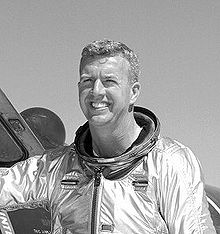Joseph Albert Walker
Joseph Albert "Joe" Walker (born February 20, 1921 in Washington , Pennsylvania , USA , † June 8, 1966 via Barstow , California ) was an American test pilot .
youth
Walker grew up on his parents' farm in Pennsylvania and had to work and care for the animals from an early age. When he was old enough, he started school and first attended the Jolly School. It was a one-room school where children of different ages were taught together. From 1934 he went to Trinity High School, which he graduated in 1938 as the fourth best in his class.
After school, Walker studied physics at Washington and Jefferson College in his native town. He was a good student, also gave lessons, and wrote a textbook with his physics teacher, Professor Raymond Bell. He earned his bachelor's degree in May 1942 and joined the United States Army Air Forces .
Career
Walker began his military career during World War II . At the beginning of 1943 he was sent to Europe, where he undertook reconnaissance flights over the Mediterranean with his P-38 "Lightning" . After 58 missions, he returned to the United States a year and a half later.
After the war, Walker took in March 1945 a job as a physicist and a test pilot at the Aircraft Engine Research Laboratory of the National Advisory Committee for Aeronautics (NACA) in Cleveland ( Ohio on). Six years later, in February 1951, he went to California to the High-Speed Flight Station at Edwards Air Force Base . In addition to many fighter planes and bombers, he also tested the X-1 experimental aircraft .
During his second flight with the X-1A on August 8, 1955, an accident occurred: Shortly before it was dropped, there was an explosion in the rocket plane in which Walker was sitting. He passed out briefly, but was then able to turn off all systems of the X-1A with his presence of mind and climb into the mother plane (a JTB-29A ). However, the accident had extended the landing gear of the experimental aircraft. A safe landing was not possible. So Walker got back into the X-1A to retract the landing gear. When one of the B-29 pilots noticed fumes from a chemical, Walker came back. It was decided to abandon the X-1A and discard it.
Between December 1955 and September 1958, Walker made 21 test flights with the X-1E.
When it was founded, Walker belonged to NASA from October 1958 . Two years later he was assigned to the X-15 program. He completed his maiden flight on this high-speed research aircraft on March 25, 1960. He undertook his fastest flight on June 27, 1962 at 6,605 km / h ( Mach 5.9).
On July 19, 1963, Walker reached an altitude of 106,010 m on the 90th test flight of the X-15, and on August 22, 1963 on the 91st flight even 107,960 m. Since the FAI sets the limit to space at 100 km altitude, Walker is a spaceman by this definition - the only one who managed this with an X-15.
Walker was the first pilot to fly the lunar module's test device on October 30, 1964 . At a height of three meters, the one-minute test was just a “hop”. He later worked for the XB-70 program.
death
Walker died in an air accident on June 8, 1966. General Electric took promotional photos of aircraft that were equipped with company-owned engines. Five machines flew in formation over California. Walker was piloting an F-104N and flying the right wing of an XB-70A . After the photo session, Walker left the formation and got caught in the tip vortex of the XB-70. The F-104's left horizontal stabilizer rammed the folded-down right wing tip of the XB-70A-2, then rolled to the left over the right wing in an inverted position and almost completely tore off both vertical stabilizers of the XB-70. Still lying on its back, it then hit the left wing of the XB-70 and exploded. Walker was instantly dead. The XB-70 went into a tailspin shortly afterwards, and the North American chief test pilot Al White was able to save himself with the ejection seat. His co-pilot, Major Carl Cross, failed - he was killed when the XB-70 hit the ground.
Walker left behind his wife Grace and four children.
Astronaut posthumously
For the American military, the limit to space is 50 miles (80.47 km). The five military X-15 pilots who exceeded this altitude were honored with astronaut wings after their flights . However, Walker was a civilian and an employee of NASA, so he was denied this award at the time. On August 23, 2005, he was honored posthumously as an astronaut in a ceremony and his family members were presented with a certificate along with a leather name tag with embroidered wings that had flown on a shuttle mission.
Walker made a total of 24 flights with the X-15 between March 1960 and August 1963.
See also
Web links
- Short biography of Joseph Albert Walker at spacefacts.de
- Biography of Joseph Albert Walker in the Encyclopedia Astronautica (English)
- DFRC: NASA Biography (English)
- Check-Six.com: The Crash of the XB-70 Valkyrie (English)
- The X-Hunters: Midair! Midair! (English)
- Joe Walker in the online archive of the Austrian Media Library
Individual evidence
- ↑ Ferdinand CW Käsmann The fastest jets in the world. P. 109 ISBN 3-925505-26-1
| personal data | |
|---|---|
| SURNAME | Walker, Joseph Albert |
| ALTERNATIVE NAMES | Walker, Joe |
| BRIEF DESCRIPTION | American test pilot |
| DATE OF BIRTH | February 20, 1921 |
| PLACE OF BIRTH | Washington, Pennsylvania |
| DATE OF DEATH | June 8, 1966 |
| Place of death | Barstow (San Bernardino County, California) |

